2014 AUDI RS7 SPORTBACK ECU
[x] Cancel search: ECUPage 174 of 292
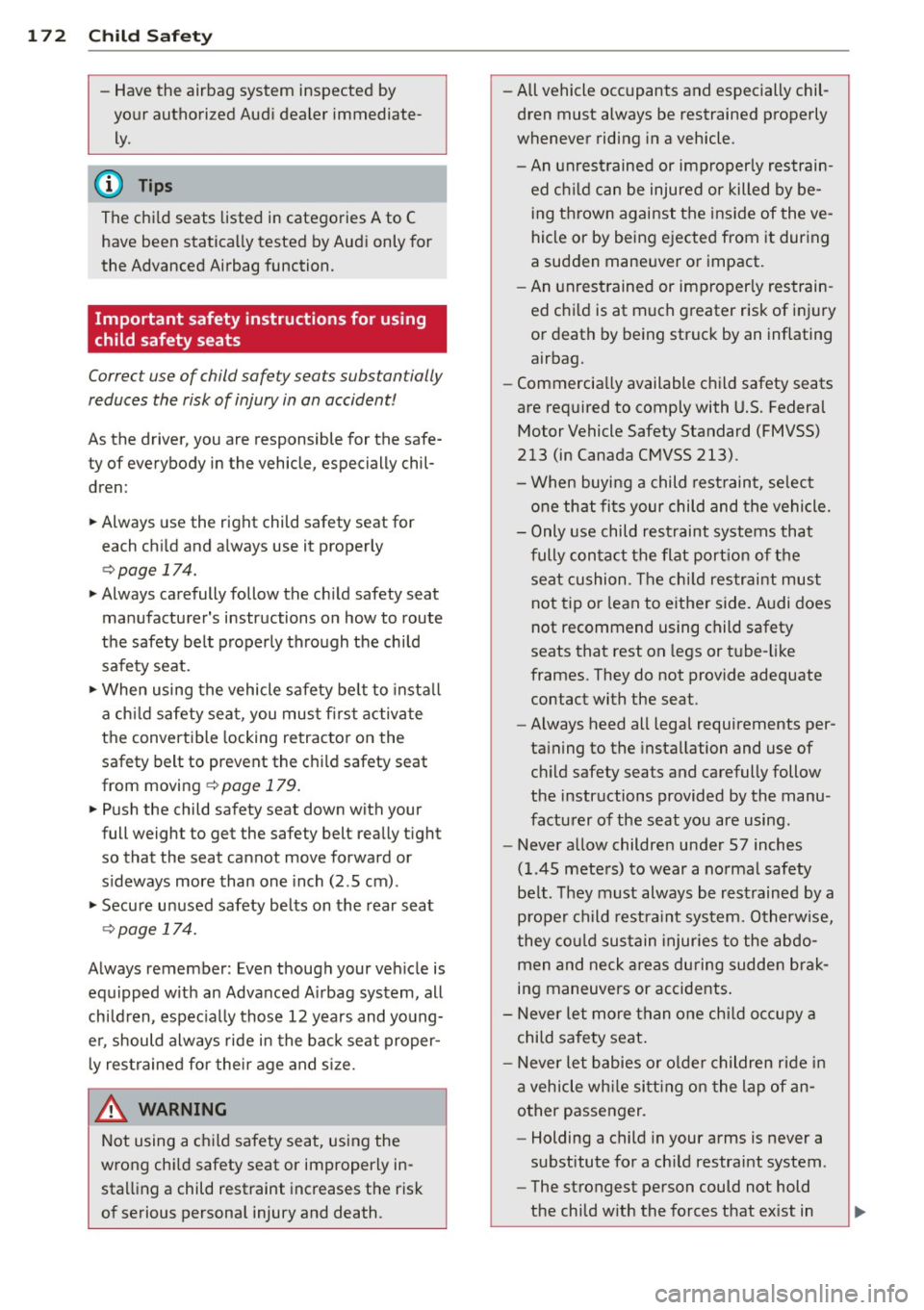
172 Child Safety
-Have the airbag system inspected by
your authorized Audi dealer immediate
ly.
The child seats listed in categories A to C have been statically tested by Audi only for
the Advanced Airbag function.
Important safety instructions for using
child safety seats
Correc t use of child safety seats substantially
reduces the risk of injury in an accident!
As the driver, you are responsible for the safe
ty of everybody in the vehicle, especially chil
dren :
• Always use the right child safety seat for
each child and always use it properly
r:::;, page 174.
• Always carefully follow the child safety seat
manufacturer's instructions on how to route
the safety belt properly through the child
safety seat.
• When using the vehicle safety belt to install
a child safety seat, you must first activate
the convertible locking retractor on the
safety belt to prevent the child safety seat
from moving
r:;, page 179.
• Push the child safety seat down with your
full weight to get the safety belt really tight so that the seat cannot move forward or
sideways more than one inch (2.5 cm) .
• Secure unused safety belts on the rear seat
r:;,page 174.
Always remember: Even though your vehicle is
equipped with an Advanced Airbag system, all
children , especially those 12 years and young
er, should always ride in the back seat proper
ly restrained for their age and size.
.&_ WARNING
Not using a child safety seat, using the
wrong child safety seat or improperly in stalling a child restraint increases the risk
of serious personal injury and death .
-
-All vehicle occupants and especially chil
dren must always be restrained properly
whenever riding in a vehicle.
- An unrestrained or improperly restrain
ed child can be injured or killed by be
ing thrown against the inside of the ve
hicle or by being ejected from it during
a sudden maneuver or impact.
- An unrestrained or improperly restrain
ed child is at much greater risk of injury
or death by being struck by an inflating
airbag.
- Commercially available child safety seats
are required to comply with U.S. Federal
Motor Vehicle Safety Standard (FMVSS)
213 (in Canada CMVSS 213).
- When buying a child restraint, select
one that fits your child and the vehicle.
- Only use child restraint systems that
fully contact the flat portion of the
seat cushion . The child restraint must
not tip or lean to either side. Audi does
not recommend using child safety
seats that rest on legs or tube -like
frames. They do not provide adequate
contact with the seat.
- Always heed all legal requirements per
taining to the installation and use of
child safety seats and carefully follow
the instructions provided by the manu
facturer of the seat you are using .
- Never allow children under 57 inches
(1.45 meters) to wear a normal safety
belt . They must always be restrained by a
proper child restraint system. Otherwise,
they could sustain injuries to the abdo
men and neck areas during sudden brak
ing maneuvers or accidents.
- Never let more than one child occupy a
child safety seat.
- Never let babies or older children ride in
a vehicle while sitting on the lap of an
other passenger.
- Holding a child in your arms is never a
substitute for a child restraint system .
- The strongest person could not hold
the child with the forces that exist in
Page 176 of 292

17 4 Child Safety
Secure unused safety belts on the rear
seat
F ig. 169 Schematic overview: keep unused safety belts
away from children in child safety seats.@-outer rear
safety belt
If a ch ild safety seat is used on the rear bench,
espec ially w ith LATCH unive rsal lower ancho
rages, the unused safety belts
mu st be se
cured so that the ch ild in the child restra in t
cannot reach them
r::;, ,&. .
-Gui de the safety belt webbing @behind the
head restraint of the seat where the child re
stra in t is ins talled
r::;, fig. 169 . When do ing
so, do not engage the switchable locking re
t ractor! You should not hear a "clicking"
sound when winding up the safety be lt.
- Let the belt re tracto r wind up the safety be lt
webbing .
~ WARNING
A child in a child safety seat installed with
the LATCH lower anchorages or w ith the
standard safety belt or a child in a booster
seat on the rear seat could play with un
used rear seat safety belts and become en
tangled . This could cause the child se rious
personal in jury and even deat h.
-Always secure unused rear seat safety belts out of reach of ch ildren in ch ild
seats such as by prope rly routing them
around the head res traint of the seat
where the child res traint is installed.
- N ever activate the sw itchab le lo cking re
tr actor when ro uting the safety belts
around the head rest raints.
Child safety seats
Infant seats
Babies and infants up to about one year old
and 20 lbs . or
9 kg need special rearward-fac
ing child restraints that support the back,
neck and head in a crash.
Fig . 1 70 Schem atic overview: rearward-fac ing infant
seat, properly installed on th e rear seat
.,. When using the vehicle safety belt to install
a child safety seat, you must first activate
the convertib le locking retractor on the
safety belt to p revent the child safety seat
from mov ing
c:;,page 179 or install the seat
using the LATCH attachmen ts .
.,.. Push the chi ld safety seat down with yo ur
full weight to get the safety belt really tight
so that the seat cannot move forward or
sideways more than one inch (2.5 cm).
.,. Secure unused safety belts on the rear seat
c:;,page 174.
Infants up to about one yea r (20 lbs. or 9 kg)
are best protected in spec ial infant carriers
and child safety seats designed for their age
group . Many experts be lieve that infants and
small ch ild ren shou ld ride on ly in sp ecial re
stra ints in wh ich the child faces the back of
t h e ve hicle. These infa nt sea ts sup port the ba
by 's back, ne ck and head in a c rash
r::;, fig. 1 70 .
The airbag on the passenger side makes the
fron t seat a pote ntia lly dange ro us place for a
c hi ld to ride. The fron t se at i s not the safest
place for a child in a forward-facing child sea t.
It is a very dange rous place fo r an infant or a
larger child in a rearward-fac ing seat .
llll>-
Page 178 of 292

176 Child Safety
the convertible locking feature on the safety
belt to prevent the child safety seat from
moving ¢
page 179 or install the seat using
the LATCH attachments .
.,. Push the child safe ty seat down with your
full weight to get the safety belt really tight so that the seat cannot move forward or
sideways more than one inch (2.5 cm)
¢ page 179.
.,. If the child safety seat is equipped with a
tether strap, attach it to the tether anchors
¢page 185.
.,. Secure unused safety belts on the rear seat
¢ page 174.
A toddler or child is usually too large for an in
fant restraint if it is more than one year old
and weighs more than 20 lbs. (9 kg).
Toddlers and children who are older than one
year up to about 4 years old and weigh more
than 20 lbs (9 kg) up to 40 lbs. (18 kg) must
always be properly restrained in a child safety
seat certified for their size and weight
¢fig. 171 and ¢fig. 172.
The airbag on the passenger side makes the
front seat a potentially dangerous place for a
child to ride . The front seat is not the safest
place for a child in a forward-facing child safe
ty seat. It is a very dangerous place for an in
fant or a larger child in a rearward-facing seat.
A WARNING
Not using a child safety seat, using the
wrong child safety seat or improperly in
stalling a child restraint increases the risk
of serious personal injury and death in a
collision or other emergency situation.
- Children on the front seat of any car,
even with Advanced Airbags, can be seri
ously injured or even killed when an air
bag inflates. A child in a rearward-facing
child safety seat installed on the front
passenger seat will be seriously injured
and can be killed if the front airbag in
flates -even with an Advanced Airbag
System . -
The inflating airbag will hit the child
safety seat or infant carrier with great
force and will smash the child safety seat and child against the backrest, center
arm rest, door or roof .
- Always install rear-facing child safety
seats on the rear seat .
- If you must install a rearward facing
child safety seat on the front passenger
seat because of exceptional circumstan
ces and the
PASSENGER AIR BAG OFF
light does not come on and stay on, im
mediately install the rear-facing child
safety seat in a rear seating position and
have the airbag system inspected by your
Audi dealer.
- The rear side of the child safety seat
should be positioned as close as possible
to the backrest on the vehicle seat.
- For adjustable head restraints: adjust or remove the rear seat head restraint if it
is difficult to install the child seat with
the head restraint in place
¢ page 57. In
stall the head restraint again immediate
ly once the child seat is removed. Driving
without head restraints or with head re straints that are not properly adjusted increases the risk of serious or fatal neck
injury dramatically.
- Always read and heed all WARNINGS
whenever using a child restrained in ave
hicle is being used
¢page 133, Safety
belts,
¢ page 142, Airbag system and
¢ page 168, Important things to know.
A WARNING ~ -
If exceptional circumstances require the
use of a forward-facing child restraint on
the front passenger's seat, the child's safe
ty and well-being require that the follow ing special precautions be taken:
- Make sure the forward-facing seat has
been designed and certified by its manu
facturer for use on a front seat with a passenger front and side airbag .
Page 180 of 292
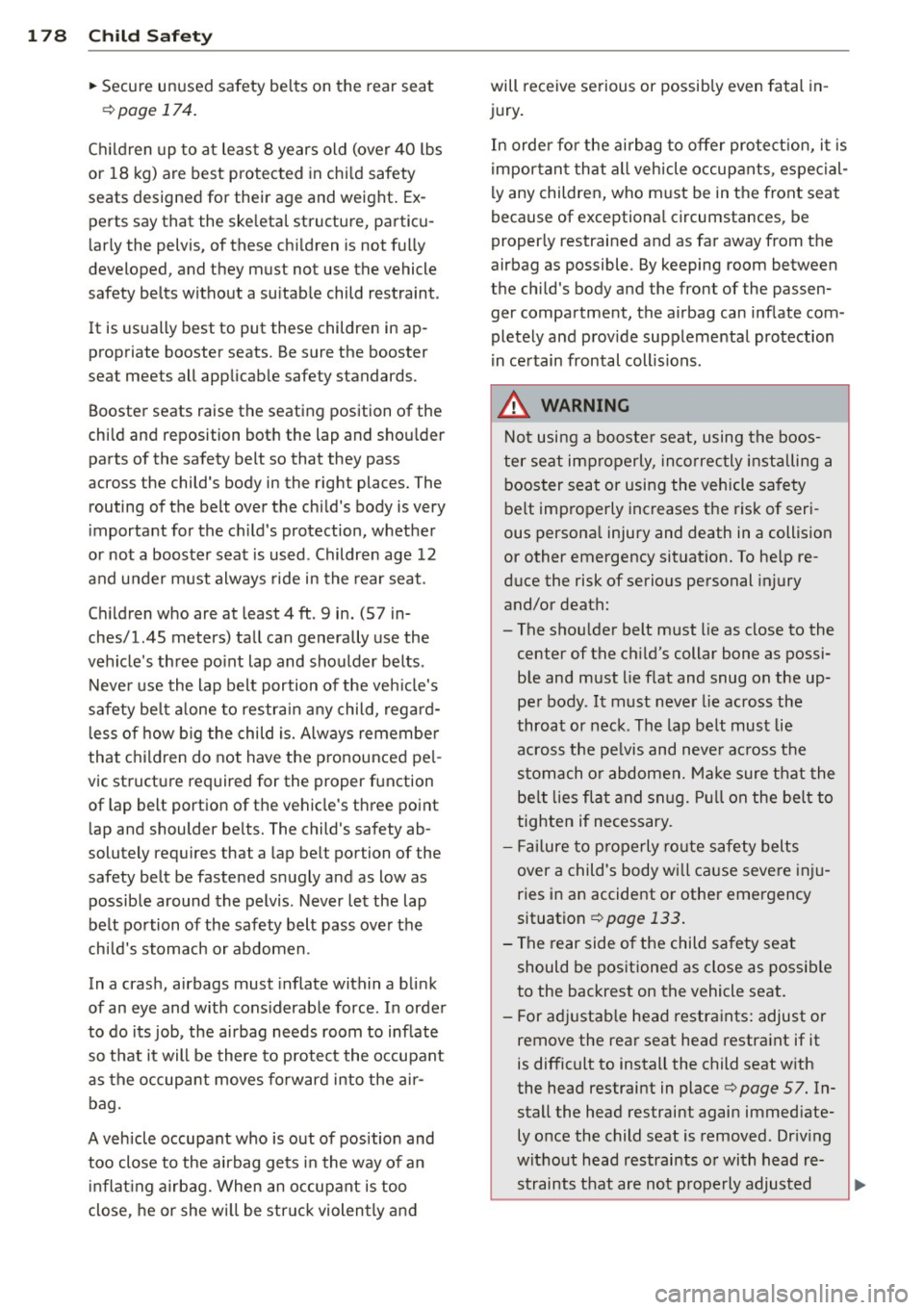
178 Child Saf ety
• Secure unused safety belts on the rear seat
r::!;> page 174 .
Children up to at least 8 years old (over 40 lbs
or 18 kg) are best protected in chi ld safety
seats designed for their age and weight . Ex
perts say that the ske leta l structure, particu
larly the pelvis, of these chi ldren is not fully
developed, and they must not use the vehicle
safety belts w ithout a su itab le child restraint .
It is us ually best to put these children in ap
propriate booster seats. Be sure the booster
seat meets all applicab le safety standards.
Booster seats raise the seating position of the
child and reposition bot h the lap and sho ulder
parts of the safety belt so that they pass
across the child 's body in the right places. The
routing of the belt over the chi ld 's body is very
important for the ch ild's protection, whethe r
or not a booster seat is used . Children age 12
and under must always ride in the rear seat.
Ch ildren who are at least 4
ft . 9 in. (S7 in
ches/1.4S meters) tall can generally use the
vehicle's three po int lap and shoulder be lts .
Neve r use the lap belt portion of the veh icle's
safety be lt alone to restrain any child, rega rd
l ess of how b ig the child is. Always remembe r
that c hildren do not have the pronounced pe l
vic st ructure required for the proper function
of lap belt portion of the vehicle's three point lap and shoulder be lts. The child's safety ab
solutely requires that a lap be lt portion of the
safety belt be fastened snugly and as low as
possib le around the pelvis . Never let the lap
be lt po rtion of the safety belt pass over the
chi ld's stomach or abdomen.
In a crash, airbags must inflate within a blink
of an eye and with cons iderab le force . In order
to do its job, the airbag needs room to inflate
so t hat it will be there to p rotect the occupant
as the occupa nt moves forw ard into the air
bag.
A vehicle occupant who is out of position and
too close to the airbag gets in the way of an
i n flat ing a irb ag. When an occupant is too
close, he or she w ill be str uck violen tly and will
receive se rious or possib ly even fatal in
jury .
In orde r fo r the ai rb ag to offer protect ion, i t is
i mpor tan t t hat a ll vehicle occup ants, espe cial
ly any children, who m ust be in the front seat
because of exceptiona l circumstances , be
proper ly restrained and as fa r away from the
airbag as possible . By keeping room between
the child's body and the front of the passen
ger compartment, the airbag can inflate com
pletely and prov ide supplemental protection
in ce rtain frontal coll isions .
.8. WARNING
Not using a booste r seat, using the boos
ter seat imp roperly, in co rrectly installing a
b oos ter seat or using the vehicle sa fe ty
belt imp roperly increases the risk of seri
ous persona l injury and death in a collision
or other emergency situat ion. To he lp re
d uce the risk of serio us personal injury
and/or death:
- The shou lder belt must lie as close to the
center of the ch ild's collar bone as possi
b le and must lie flat and snug on the up
per body . It must neve r lie across the
throat or neck . The lap belt must lie
across the pe lvis and neve r acr oss t he
s tomach o r abdomen.
M ake sure t hat the
be lt lies flat and snug. P ull on the bel t to
tighten if necessary.
- Failure to p roperly ro ute s afe ty belts
over a child's body wi ll ca use seve re inj u
ries in an accident o r other emergency
situation
¢ page 133 .
-The rear side o f the child sa fety seat
should be pos itioned as close as possib le
to the backrest on the vehicle seat.
- For ad justab le head restraints: adjust or
remove the rea r seat head restra int if it
is difficult to install the child seat with
the head restraint in place
c:> page 57. In
stall the head restraint again immed iate
ly once the child seat is removed . Dr iv ing
without head restraints o r with head re-
.
straints that are not p roperly adjus ted Ii),
Page 181 of 292
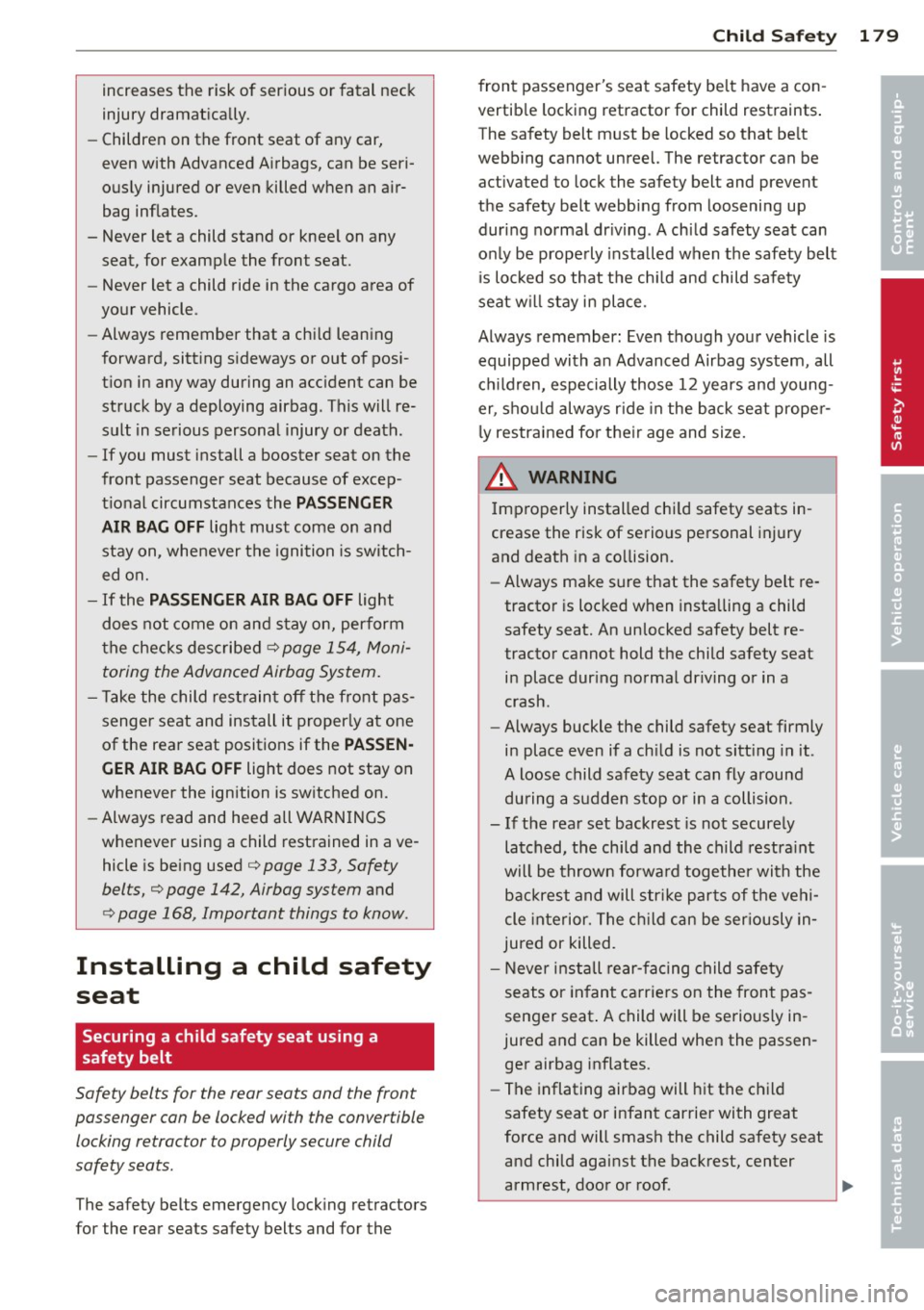
increases the risk of serious or fatal neck
injury dramatically.
- Children on the front seat of any car,
even with Advanced Airbags, can be seri
ously injured or even killed when an a ir
bag inf lates.
- Never let a child stand or knee l on any
seat, for examp le the front seat.
- Never let a child ride in the cargo area of
yo ur vehicle.
- Always remember that a ch ild lean ing
forward, sitt ing s ideways or out of posi
t ion in any way during an acc ident can be
struck by a deploying airbag. This will re
sult in se rious personal injury or death .
- If you must install a booster seat on the
front passenger seat because of excep
t ional circumstances the
PASSENGER
A IR BAG OFF
light must come on and
stay on, whe never the ignition is switch
ed on.
- If the PASS ENGER AIR BAG OFF light
does not come on and stay on, perform
the checks described¢
page 154, Moni
toring the Advanced Airbag System.
- T ake the child rest rain t off the fron t pas
senger seat and install it proper ly at one
of the rear seat positions if the
PASSEN
GER AIR BAG OFF
light does not stay on
whenever the ignition is switched on.
- Always read and heed all WARNINGS
whenever using a child restrained in ave
hicle is being used¢
page 133, Safety
belts,¢ page 142, Airbag system
and
¢page 168, Important things to know.
Installing a child safety
seat
Securing a child safety seat using a
safety belt
Safety belts for the rear seats and the front
passenger can be locked with the convertible
locking retractor to properly secure child
safety seats.
The safety belts emergency lock ing retractors
for the rear seats safety belts and for the
Child Sa fet y 1 79
front passenger's seat safety be lt have a con
vertib le locking retractor for child restraints .
The safety belt m ust be locked so that be lt
webb ing cannot unreel. The retractor can be
activated to lock the safety belt and prevent
the safety belt webbing from looseni ng up
dur ing normal dr iv ing . A child safety seat can
on ly be properly insta lled when the safety belt
is locked so that the chi ld and child safety
seat w il l stay in place .
Always remember : Even though your vehicle is
equipped with an Advanced Airbag system, all
c hi ldren, especially those 12 years and young
er, shou ld always r ide in the back seat prope r
ly restrained for the ir age and size.
A WARNING r----------
1 mp rope rly installed chi ld safety seats in-
crease the risk of serious personal injury
and death in a co llision.
- Always make s ure that the safety belt re
tractor is locked when insta lling a child
safety seat. An unlocked safety belt re
tractor cannot hold the child safety seat
in place dur ing norma l dr iving or in a
crash .
- Always buckle the child safety seat firmly
in place even if a ch ild is not sitt ing in it .
A loose child safety seat can fly around
during a sudden stop or in a collision.
- If the rea r set backrest is not secure ly
latched, the child and the child restra int
w ill be thrown forwa rd togethe r with the
backrest and will str ike parts of t he vehi
cle interior. The ch ild can be ser iously in
jured or killed.
- Never install rear-facing child s afety
seats or in fant carrie rs on the front pas
senger seat . A child will be serio usly in
jured and can be killed when the passen ger airbag inflates.
- The inflating airbag will hit the child
safety seat or infant carrier with great
force and will smash the child safety seat
and child against the backrest, center
armrest, door or roof . •
•
Page 183 of 292
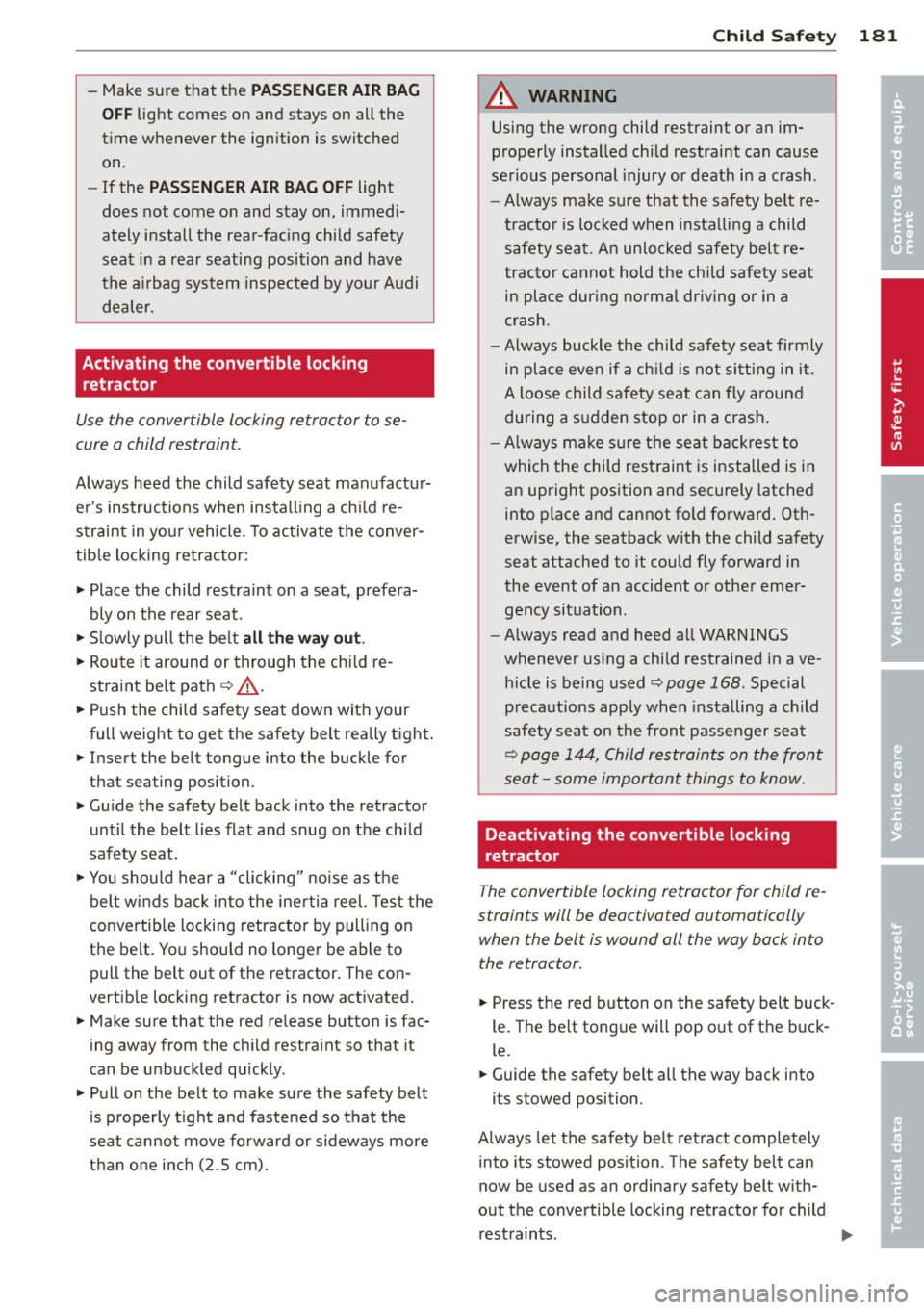
-Make sure that the PA SSENGER AIR BA G
OFF
light comes on and stays on all the
t ime whenever the ignition is switched
on.
- If the
PA SS ENGER AIR BAG OFF light
does not come on and stay on, immedi
ately install the rear -facing child safety
seat in a rear seating position and have
the a irbag system inspected by your Audi
dealer.
Activating the convertible locking retractor
Use the convertible locking retractor to se
cure a child restraint .
Always heed the child safety seat manufactur
e r's instructions when install ing a ch ild re
straint in you r vehicle. To activate the conver
tible locking retractor:
.,. Place the child rest raint on a seat, prefera
bly on the rear seat.
.,. Slow ly pull the be lt
a ll th e wa y out .
.,. Route it around or through the chi ld re
straint be lt path ¢.&_ .
.,. Push the child safety seat down with your
full weight to get the safety belt rea lly tight.
.,. Insert the belt tongue into the buckle for
that seating position .
.,. Gu ide the safety belt back into the retractor
until the belt lies flat and snug on the child
safety seat .
.,. You should hear a "clicking " noise as the
belt w inds bac k into the ine rtia reel. Test the
convertible locking retractor by pulling on
the belt . You should no longer be able to
pull the belt out of the retractor . The con
vertib le locking retractor is now activated.
.,. Make sure that the red re lease button is fac
ing away from the chi ld restraint so that it
can be unbuckled qu ickly .
.,. Pull on the belt to make sure the safety belt
is p roperly t ight and fastened so t hat the
seat cannot move fo rward or sideways mo re
than one inch (2.5 cm).
Child Sa fet y 181
A WARNING
Using the wrong child restraint or an im
properly installed chi ld restraint can cause
serious pe rsonal injury or death in a c rash .
- Always make sure that the safety belt re-
tractor is loc ked when insta lling a child
safety seat. An unlocked safety belt re
tracto r cannot hold the child safety seat
in place dur ing no rma l dr iving o r in a
crash.
- Always buckle the child sa fety seat firmly
in place even if a ch ild is not si tt ing in it.
A loose child safe ty seat can fly around
during a s udden stop or in a crash .
- Always ma ke sure the seat backrest to
which the child res traint is installed is in
an upright position and securely latched
into place and cannot fold forward. Oth
erwise, the seatback with the child safety
seat attached to it could fly forward in
the event of an accident o r other emer
gency situation.
- Always read and heed all WARNINGS
whenever us ing a child restrained in ave
hicle is being used ¢
page 168. Special
precautions apply when insta lling a child
safety seat on the front passenger seat
¢ page 144, Child restraints on the front
seat -some important things to know.
-
Deactivating the convertible locking
retractor
The conv ertibl e locking retractor for child r e
straints will be deactivated automatically when the belt is wound all the way back into
the retractor.
.,. Press the red b utton on the safety belt buck
le . Th e belt tong ue will pop out of t he b uck
le .
.,. Guide the s afety belt all the way back into
i t s s towed position .
A lways let the safety be lt retract completely
into its stowed position. The safety belt can
now be used as an ordinary safety belt w ith
out the convertible locking retractor fo r child
restraints.
•
•
Page 184 of 292

182 Child Saf ety
If the convertible locking retracto r shou ld be
activated inadvertently, the safety belt must be unfastened and guided completely back in
to its stowed pos ition to deactivate th is fea
ture. If the convertible locking retractor is not
deactivated, the safety belt will gradually be
come tighter a nd uncomfortable to wear.
A WARNING
Improperly insta lled child safety seats in
crease the risk of ser ious personal inju ry
and death in a collision.
- Never unfasten the safety belt to deacti
vate the convert ible lo ck ing ret ractor for
child rest rain ts while the veh icle is mov
ing. You would not be restrained and
cou ld be ser iously injured in an accident.
- Always read and heed all WARNINGS
whenever using a child rest rained in ave
hicle is being used
¢page 168. Special
precautions apply when installing a ch ild
safety seat on the front passenger seat
¢ page 144, Child restraints on the front
seat -some important things to know.
LATCH Lower
anchorages and tethers
for children
Child Restraint System anchors and how
are they related to child safety
To provide a s imp ler and more prac ticable way
to attach the chi ld restraint on the vehicle
seat, Federa l reg ulations require specia l lower
anchorages in vehicles and devices on new
child restraints to attach to the vehicle ancho
rages.
The combination of the tether anchorages and
the lower anchorages is now generally called
the
LATCH system for " Lower Anchorages and
T ethers for Children."
F orward-facing child rest raints manufactured
after September 1, 1999, are required by U .S .
federal regulations to comply with new child head movement performance requirements. T
hese new performance req uirements make a
tethe r necessary on most new child seats.
Installing a c hild restra int tha t requires a top
tether wi thou t one can seriously impa ir the
performance of the chi ld restra int and its abil
ity to protect the child in a collision . Insta lling
a chi ld restraint that req uires a top tether
without the top tether may be a violat ion of
state law.
Child restraint manufacturers offer LA TCH
lower anchorages on their child seats w ith
hook-on or push-on connectors attached to
adjustable straps.
In addition to the LATCH lower anchorages,
these chi ld restraint systems usua lly require
the use of tether straps to he lp keep the chi ld
restraint firmly in place.
A WARNING ,.__ -
Improper installat ion of child restra ints
will increase the r isk of injury and death in
a crash.
- Always follow the instructions provided
by the manufacture r of the child re
straint you intend to install in your ve hi
cle.
- Never install a chi ld restrai nt without a
p roperly attached top tether strap if the
child res tra int m anufa cture r's instruc
tions require the top tether st rap to be
used .
- I mp roper use of child restraint LA TC H
lowe r ancho rage poin ts can lead to injury
in a co llision. The LATCH lower anchorage
points are designed to withstand on ly
those loads imposed by correctly fitted
child restraints.
- Never mo unt two child restraint systems
on one LATCH lower anchorage point.
- Never secure or attach any luggage or
other item to the LATCH lower anchorag
es.
Page 185 of 292
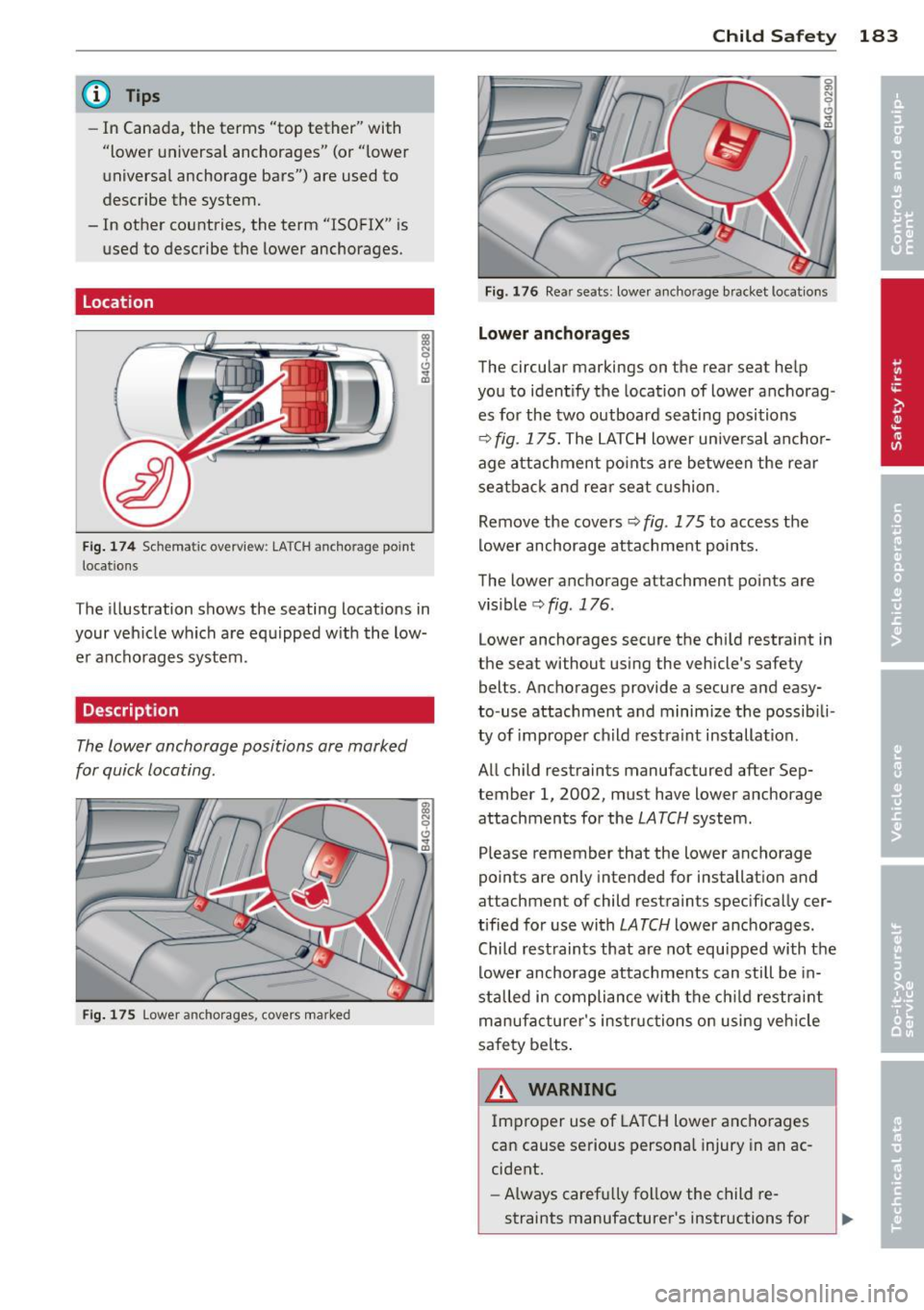
@ Tips
-In Canada, the terms "top tether" with
"lower universal anchorages" (or "lower
universal anchorage bars") are used to
describe the system.
- In other countries, the term "ISO FIX" is
used to describe the lower anchorages.
Location
Fig . 174 Schematic overview: LA T CH ancho rage point
locations
The illustration shows the seating locations in
your veh icle which are equipped w ith the low
e r anchorages system .
Description
The lower anchorage positions are marked
for quick locating .
Fig. 175 Lower anchorages , covers marked
Child Safety 183
Fig. 176 Rea r seats: lower anchorage bra cket locat ions
Lower anchorages
The circular markings on the rear seat help
you to ident ify the location of lower anchorag
es for the two outboard seating positions
¢ fig. 175. The LATCH lower unive rsal anchor
age attachment points are between the rear
seatback and rear seat cushion .
Remove the covers¢
fig. 175 to access the
lower anchorage attachment points.
The lower anchorage attachment points are
vis ible ¢
fig . 176.
Lower anchorages secure the chi ld restraint in
the seat without using the vehicle's safety
belts. Anchorages provide a secure and easy
to-use attachment and minimize the possib ili
ty of improper child restraint installation.
All child restraints manufactured after Sep
tember 1, 2002, must have lower anchorage
attachments for the
LATCH system.
Please remember that the lower anchorage
points are only intended for installation and
attachment of child restraints specifically cer
tified for use with
LATCH lower anchorages .
Child rest raints that are not equipped with the
lower anchorage attachments can still be in
stalled in compliance with the child restraint
manufacturer's instructions on using veh icle
safety belts.
A WARNING ~
Improper use of LATCH Lower anchorages
can cause serious personal injury in an ac
cident.
- Always carefully follow the child re
straints manufacturer's instructions for